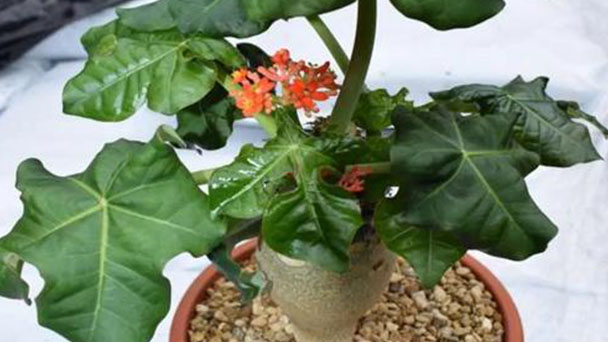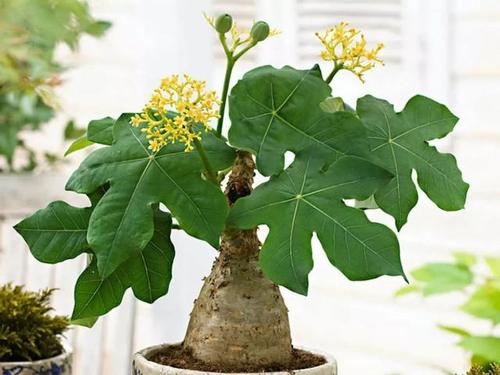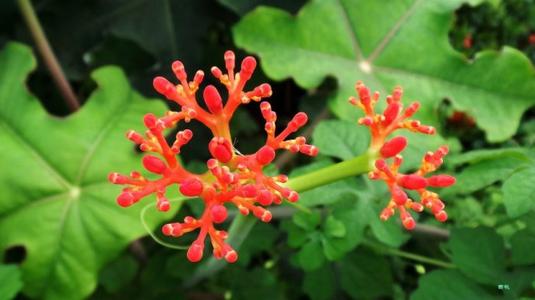Buddha Belly Plants (Jatropha Podagrica) Profile
Written by Maggie
Oct 13 2021

Buddha Belly Plants (Jatropha podagrica Hook.), also called Gout Plant, Gout Stick, Guatemala Rhubarb, Tartogo, are fleshy shrubs of the genus Claudia in the Euphorbia family. Buddha Belly Plants have swollen oval-shaped stems at the base and bifurcated stems at the end. The stem epidermis is gray and easy to fall off. Leaves clustered apically branched, green, smooth and slightly waxy pinkish. Stipules are horny , bifurcated, spiny, persistent on stems and branches for a long time. Inflorescences are 15 cm long, repeated bifurcation, bright red flowers.
Buddha Belly Plants are native to Australia. They are the dominant plants in the open tropical forests there. Buddha Belly Plants are exotic plants that bloom all year round, and have long been popular indoor potted plants in China. Fujian Zhangzhou Castle Peak Nursery and Guangdong have large-scale cultivation. Note that the Buddha Belly Plants also contain a poisonous white SAP.
Buddha Belly Plants Picture

Buddha Belly Plants Characteristics
Buddha Belly Plants Branch
Buddha Belly Plants are erect shrubs, unbranched or less branched, 0.3 -- 1.5 m tall, usually flask shaped at the base or lower part of the stem. Branches are thick, short, fleshy, with scattered protuberant lenticels, leaf marks big and obvious.
Buddha Belly Plants Leaf
The leaves of Buddha Belly Plants are spatulate, subrounded to broadly elliptic in outline, 8 -- 18 cm long and 6 -- 16 cm wide, obtuse at the top, truncate or obtuse at the base, entire or 2-6 lobed, light green above, grayish green below, glabrous on both sides; Buddha Belly Plants has 6-8 palmate veins, of which the upper 3 direct leaf margin; Petiole is 8-16 cm long, glabrous; Stipules fission is spiny, persistent.
Buddha Belly Plants Flowers
Inflorescences of Buddha Belly Plants are terminal, with long peduncles, branches short, red, calyx ca. 2 mm, lobes subrounded, ca. 1 mm; Petals are ovate-oblong, ca. 6 mm, red; Male flowers: Stamens 6-8, basally connate, anthers and filaments subequal; Female flowers: Ovary glabrous, style 3, base connate, apical 2-lobed.
Buddha Belly Plants Fruit
Capsule of Buddha Belly Plants is elliptical, 13 -- 18 mm long, 15 mm in diameter, with 3 longitudinal furrows; Seeds ca. are 1.1 cm long, smooth.
Buddha Belly Plants bloom all year round.
Buddha Belly Plants Habits
Buddha Belly Plants love the sun and grow best in an environment between 22℃ and 28℃. Accordingly, whole growth period divides phlogistic summer outside proper shading, should satisfy its adequate illumination. After late autumn enters a room, we need to put Buddha Belly Plants in the windowsill facing south, let it accept light more, or use lamplight to make an auxiliary illuminant. Buddha Belly Plants will bloom as long as the room temperature is kept above 20 ° C and they are kept in light for about 6 hours. In winter, the room temperature should not be lower than 10℃, which means the winter can be safely overwintering. However, it leaves easily but can still flower.
Buddha Belly Plants Care
Buddha Belly Plants Watering & Fertilizer
Drought-resistant, watering in the growing season should be dry and wet, especially in autumn and winter when the temperature is low, watering should be reduced, and the basin soil should be slightly dry. However, in the summer high temperature season, water is indispensable. In addition to pouring enough water in the morning, you must observe the soil in the evening to replenish some water. In the noon high temperature, you must spray some water to the branches, leaves and ground of Buddha Belly Plants to prevent heat and cool down. During the growing period, apply liquid fertilizer once or twice a month. The fertilizer is mainly phosphorus and potassium, and the ratio of fertilizer to water is 20%-30%. If you keep using 0.2% potassium phosphate solution and spray the leaves, the flowers will blossom the most brightly. Stop fertilizing in winter.
Buddha Belly Plants Moisture care
In the summer:
(1) Strengthen air convection so that the temperature in the body can be emitted;
(2) Put Buddha Belly Plants in half shade, or give it 50% shade;
⑶ Spray it properly, 2-3 times a day.
In the winter:
⑴ move to a bright indoor place for maintenance;
(2) in the outdoor, available film to wrap it up for winter, but every two days in the noon when the temperature is higher to uncover the film to let it breathe;
Buddha Belly Plants Light care
The leaf color of Buddha Belly Plants will be more beautiful in the summer when it is preserved in half shade or 50% shade. In spring and autumn, because the temperature is not very high, it is necessary to give Buddha Belly Plants direct sunlight, in order to facilitate the accumulation of nutrients for photosynthesis. In winter, put in a place that has bright indoor indoor maintenance.
Put in indoor maintenance at ordinary times, should be put in southeast to the door window nearby, in order to be able to receive the light, and every pass a month or a month and half a month, want to move outdoor maintenance 2 months, otherwise leaf grows thin, yellow, new branch or leafstalk fine, internode elongate, be in long condition.
Buddha Belly Plants Water care
Buddha Belly Plants are very drought-tolerant and can grow in dry environmental conditions, but that does not mean not watering or fertilizing it;Its roots are afraid of water stains, if the pot water, or give it too frequently watering fertilizer, it is easy to cause root rot. Give Buddha Belly Plants the principle of watering fertilizer watering is "between dry wet, dry to dry thoroughly, don't do not pour, pour on pour thoroughly", when watering fertilizer water day to avoid the plant wet.
Buddha Belly Plants Care in Spring & Autumn
These two seasons are the peak season for its growth. Fertilizer and water management follows the sequential cycle of "Huabao" -- "Huabao" -- "Huabao" -- "Qingshui". The interval period is about 2-4 days for outdoor maintenance. Put Buddha Belly Plants in the indoor curing for 3-6 days.
Buddha Belly Plants Care in Summer
Buddha Belly Plants often enter dormant state in the summer high temperature period, do not require much fertilizer and water, and even must control fertilizer and water. Fertilizer and water management follows the sequential cycle of "Huabao" -- clean water -- clean water -- "Huabao" -- clean water -- clean water, and the interval period is about 3-5 days for outdoor curing; Put Buddha Belly Plants in the indoor maintenance of 4-7 days.
Watering time to try to arrange in the morning or evening when the temperature is low. Spray the plants often.
Buddha Belly Plants Care in Winter
During the winter dormant period, it is mainly to do a good job of controlling fertilizer and water, and the interval period is about 7-10 days. Watering time as far as possible to arrange in the sunny noon when the temperature is higher.
Buddha Belly Plants Soil & Transplanting
The jatropha grows best in well-drained cactus soil. If no cactus soil is available, use a combination of regular potting soil with 25% pumice.
When young start the plant in a small pot and repot each year in the spring. As the plant gets taller, it needs transplanting to freshen the soil or when it outgrows its current ot.
Buddha Belly Plants Pruning
No pruning is required to care for the jatropha podagrica. Remove dead leaves as needed.
Buddha Belly Plants Size & Growth Rate
Buddha flora can attain quite a few toes tall. When it reaches full height, the swollen stem resembles a trunk, making the plant appear extra like a small tree with a sparse crown containing a few giant leaves.
The gout plant is a gradual developing plant. The stem developing from the floor frequently has numerous smaller stems sprouting from the pinnacle that produce clusters of flowers.
As the plant grows, the exterior parts of the stem swell up and thicken. The swollen base is the place the plant shops its water reservoir.
Buddha Belly Plants Flowering & Fragrance
The plant Jatropha podagrica doesn’t continually bloom, mainly when grown indoors.
It requires most appropriate prerequisites to motivate the plant life to bloom, which show up in clusters from lengthy stems. The vegetation is vivid coral purple and doesn't have a scent.

Buddha Belly Plants Propagation
Buddha Belly Plants have two kinds of propagation: sowing and cutting. After the seeds are harvested, they are first stored at 20℃-30℃, sown in summer, and germinate 3 to 6 months after sowing. Cuttings can be conducted in May - June, will pick the top of the forked twig 10 cm to 15 cm long, 0.5 cm in period of cut, ventilated place 2 hours to 3 hours, after being cut or insert after clean coal cinder, and shortens the sunshine, keep coal cinder between temperature of 22 ℃ to 25 ℃, about 20-30 days to take root, roots to 2 cm - 3 cm long when on basin.
Propagation is often seeded, the stem of an annual seedling is slightly enlarged. Buddha Belly Plants can also be propagated from cuttings.
Propagation multi-purpose seeding, sowing 25-30 days after the emergence of seedlings, one-year seedlings that slightly enlarged stem. Buddha Belly Plants can also be propagated from cuttings. Rooting took 15-20 days at 22-24℃. Potted soil should be dry, and thin fertilizer can be applied as appropriate during the growing season.
Grafting propagation
(1) Select Buddha Belly Plants with bulbous bulbs as scions in the early morning of spring and autumn or after 4:00 PM. Dig out the roots, remove part of the leaves, retain the taproots 15-20 cm below the bulbs, cut off the rest, rinse the soil, and put them in a shady place to air dry. After its surface moisture dries, it can be used for grafting;
Diction cleft grafting method, grafting was used to survive tall paste tong for stock, according to the position of hope grafting, stem thick small to select a scion, choose the right stock and scion, in position cut dry, split along the vertical line to the appropriate depth, the scion of bulb taproot cut into wedges, 9-11 cm long, split into stock, align the cambium, inserted tightly;
(3) Use a 1.5-3 cm wide plastic binding band to tie strong, scion and rootstock tightly together, and pay attention to the interface waterproof;
(4) When the interface is fully healed and naturally thickened, the binding affects the grafted plant growth about 6 months later, and then untie the binding to ensure the interface is firmly adhered;
(5) According to the above steps in the paste tung branch grafting, so the enlarged bulb moved to paste tung tree as a new plant to grow together.
Seed propagation
Seed selection
Before sowing, we must first select the seeds of Buddha Belly Plants. The seeds are well chosen, which is directly related to the success of sowing.
The best is to choose the seeds that were harvested that year. The longer the seed is kept, the lower its germination rate will be.
The selection of full grain, no incomplete or deformed seeds.
Choose seeds that are free of pests and diseases.
Disinfection
Disinfection consists of two concepts, one refers to the disinfection of the seed, and the other refers to the disinfection of the substrate used for sowing.
Families often disinfect seeds by soaking them in hot water at about 60℃ for 15 minutes.
The best way to disinfect the substrate used for sowing is to put it in a wok and heat it up, which will kill any insects and diseases.
Sprouting
Soak the seeds of Buddha Belly Plants in warm water (about the same temperature as your face wash) for 12-24 hours, until the seeds absorb water and swell. For very common seeds that germinate easily, this job can be left out.
Sow
Place the seeds of Buddha Belly Plants in the substrate and seed on demand. After sowing, the substrate was covered with a thickness of 2-3 times that of seed grains. After sowing available sprayer, fine pore sprinkle sowing matrix quality wet, when the basin soil is slightly dry and then drenched, still pay attention to the strength of watering can not be too big, so as not to flush up the seeds.
Disease Control of Buddha Belly Plants
Buddha Belly Plants mainly have blowing and ulcer diseases.It is mainly parasitic on the flowers of Buddha Belly Plants. It can be killed by oxidizing dimethoate 2000 times and rinsed with clean water immediately after 10 minutes to avoid fester of stem and leaves. Ulcerative wounds are found under the stems of Buddha Belly Plants. Move Buddha Belly Plants to the ventilated place immediately. After scraping the rotten tissue with a sharp knife, apply sulfur powder and spray carbendazim once or twice to make the wound heal.
Buddha Belly Plants Distribution
Buddha Belly Plants are native to Central America or tropical South America.Now cultivated as an ornamental plant. Many Chinese provinces and regions garden departments and flower hobby also have cultivation.
Buddha Belly Plants Uses
Medical uses
Buddha Belly Plants can clear heat and detoxification, detumescence and hemostasis.
Landscape value
Buddha Belly Plants like warm, dry and sunny conditions. They are strong, unique and easy to grow. Buddha Belly Plants are excellent for indoor potted plants. Warm land can also be garden cultivation, but also do garden trees, handicrafts.
Buddha Belly Plants are unique in shape and stand out for their large, flask shaped trunks with lots of water in them. They are unique in shape and bloom continuously all year round. Buddha Belly Plants are the best indoor potted plants in China for a long time. Buddha Belly Plants like warm, dry environments, especially full of sun. Home plants should not be kept in the shade, otherwise they will become slender and dry and lose their Buddha belly. Sand loam soil with good drainage should be used for pot planting. Poor drainage or too much watering often leads to rotten roots. Dry pot soil should be used for cultivation. Growing season can be appropriate to put thin decomposed liquid fertilizer. The suitable temperature for Buddha Belly Plantsgrowth is 26℃ to 28℃. If the temperature is lower than 10 ℃, it is easy to fall leaves but can still blossom. Leaves after the plant should be strictly controlled watering, keep the basin soil dry.

Latest Updated
- Benefits of Bugleweed - 7 Science-backed Health Benefits
- Bugleweed Dangers & Side Effects - Is It Poisonous?
- How to Plant Evergreen Trees - What You Should Know
- When to Plant Evergreens - Grow Guide for Evergreen Trees
- 12 Wonderful Evergreen Shrubs for Your Garden
- 12 Popular Evergreen Plants with Pictures for Beginners
- When And How To Prune A Lilac Bush Like a Pro
- How to Grow & Care for Lilac Vine (Hardenbergia Violacea)
- Japanese Lilac Tree (Syringa Reticulata) Care & Propagation Guide
- Shumard Oak Pros and Cons - What to Know
Popular Articles
- Winter maintenance of Antirrhinum Majus
- How to Grow Terminalia Mantaly Tree
- How to Grow and Care for Crossostephium Chinense
- How to grow Antirrhinum Majus in spring
- Peristeria Elata (Dove Orchid) Profile: Info & Care Guide
- Underwatered Snake Plant (Sansevieria Trifasciata) - Signs And How To Fix
- How to Care for Brazilian Jasmine Plant (Mandevilla Sanderi)
- How to Grow & Care for Graptopetalum Purple Delight in Summer
- Rosa Chinensis (China Rose): Plant Growing & Care Tips
- How to Care for Baby Sun Rose (Aptenia Cordifolia)